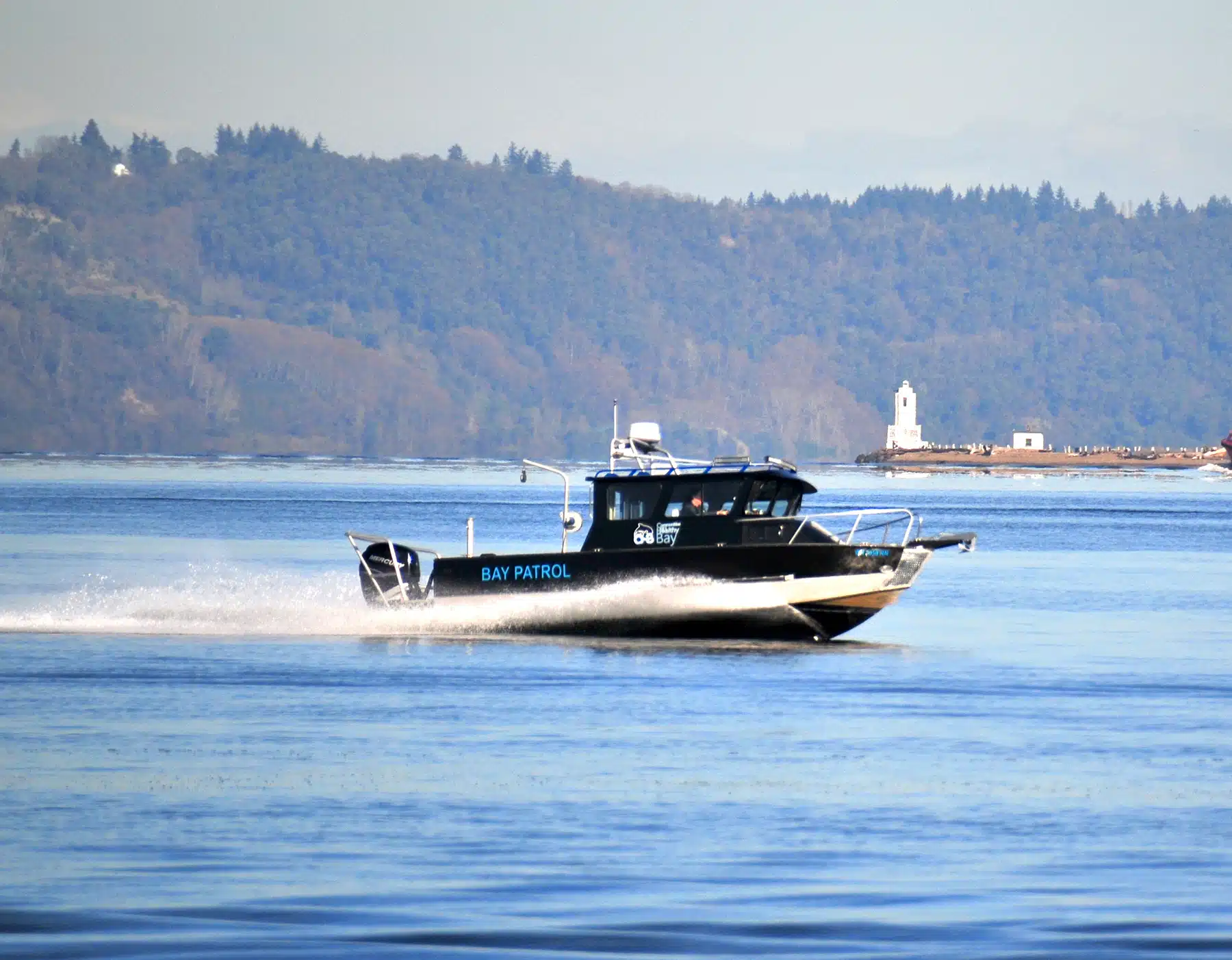
Tacoma’s Tideflats are being targeted for the ever-growing development demands of the fossil fuel industry. Recognizing this area’s vulnerability to development, and the need to limit the impacts of hazardous industries like oil refineries and distribution centers on the “health, safety and welfare of the public and the local environment…” Tacoma City Council enacted the Tideflats Interim Regulations back in 2017.1 These regulations prohibit the dirtiest, most-polluting types of fossil fuel facilities from setting up shop in the Tideflats, and set a baseline for the Tideflats Subarea Plan.
Despite the overwhelming scientific consensus that our use of fossil fuels is causing the climate crisis, the fossil fuel industry in Tacoma has decried these regulations as overly burdensome, a threat to “family wage jobs”, and responsible for a chaotic market environment for “small, local business”.* All-the-while, they have had no trouble getting the green light to move more fossil fuels through Tacoma by using carefully crafted phrasing in their permit applications that blurs the real intentions of their proposals.
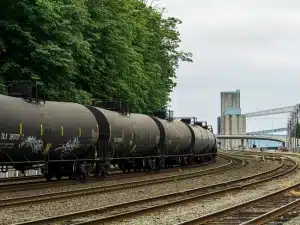
But the Tideflats Interim Regulations need to be stronger – fossil fuel facilities that were here when the regulations were first enacted get a free pass to double or even triple the amount of fossil fuels they can bring through Tacoma by ship or by rail. The two biggest companies, U.S. Oil & Refining Co. and SeaPort Sound Terminal (formerly Targa) are moving more fossil fuels through Tacoma year-by-year, and show no signs of slowing down. Despite recent crashes in the fossil fuel market, we know this is market volatility, and the industry will continue to thrive when conditions return to normal.
Since U.S. Oil was purchased by Par Pacific Holdings back in the fall of 2018, it has become clear that the intent of the new owner is to change the use of the Tacoma refinery to become the newest crude oil export hub for Hawaii – which is in fact prohibited under the Tideflats Interim Regulations. Meanwhile, SeaPort Sound recently got the go ahead to double the number of crude oil rail cars they can bring onto their property. These are just two instances of the fossil fuel industry moving the baseline that was intended to set the standard for the Tideflats Subarea Planning process.
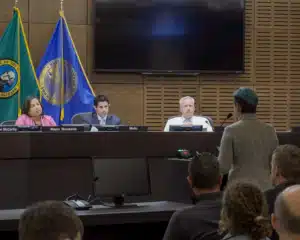
Tacoma City Council has the power to protect this community from the demands of the fossil fuel industry. In the fall of 2019, they showed real leadership by becoming the first city in the state to pass a Climate Emergency Resolution, which recognized the threat of climate change to Tacoma and its residents. City Council can take further action – action that accurately reflects the threat posed by climate change and the fossil fuels that contribute to it – by amending the Tideflats Interim Regulations to include a pause on the expansion of existing facilities within the Tideflats.
Interested in how we came to these conclusions? Keep reading.
Both U.S. Oil and SeaPort Sound have permits that tell them how much crude oil they can send out on ships over any 12-month period. We compared those permits with the crude oil shipping data, and were blown away by the potential these companies have to bring significantly more oil-carrying vessels through Commencement Bay every year. Depending on the destination of the oil and type of vessel, if these companies reached their potential, we could see anywhere from 200 to 1,235 more oil-carrying vessels every year – each one of them putting us at risk of a catastrophic oil spill in Commencement Bay. And we still don’t fully understand the economic consequences of a large oil spill in the Salish Sea, let alone here in Tacoma. Here’s how it breaks down:

In case you’re struggling to conceptualize how huge these volumes are, think of it this way: one Olympic swimming pool could hold 15,720 barrels of crude oil. You’d need 928 of these pools to hold the 14.6 million barrels of crude oil that SeaPort Sound is allowed send out by boat every year.
Since 2016, more crude oil has been delivered to Tacoma by rail than the year before. At a finer scale, there was a 67% increase in crude oil rail deliveries from the 4th quarter of 2016 compared to the 4th quarter of 2019. That’s 2,225 more rail cars – each carrying the potential to derail, catch fire, and burn for days, like the 2016 derailment of a train that was headed to U.S. Oil. Further, of the crude oil that gets unloaded in Tacoma, more and more of it has been heavy crude oil – which in the event of a spill on water, is nearly impossible to cleanup because this type of crude oil sinks in water.
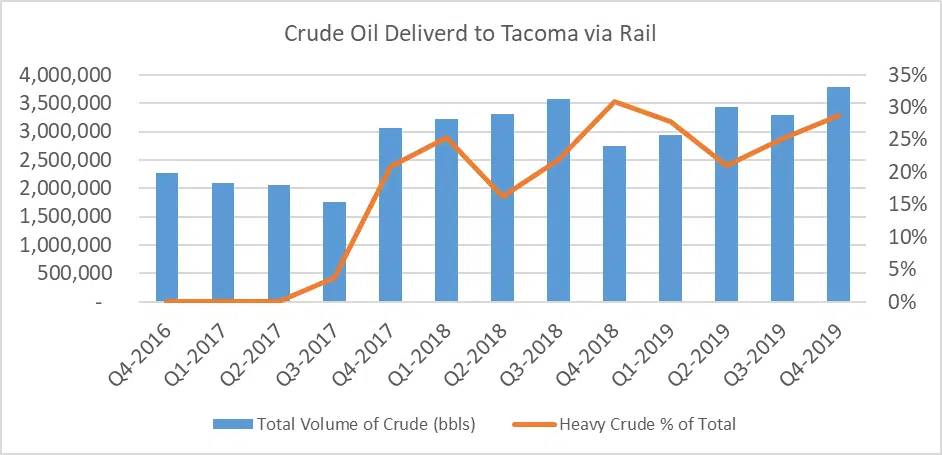
U.S. Oil is owned by the Houston-based Par Pacific, which has touted that they intend to change the use of U.S. Oil from a refinery to a crude oil export hub for their Hawaii location. U.S. Oil is taking the crude they receive via rail, and loading it onto boats to be dropped off at other ports in the Salish Sea, and even taking it across the Pacific Ocean. And, they’re making bigger and bigger deliveries. For example, U.S. Oil almost doubled the amount of crude oil they exported out by ship in the 4th quarter of 2019 compared to the 4th quarter of 2016 – further, all of that crude oil went to Hawaii, all 235,336 barrels of it.4
In October of 2019, SeaPort Sound got the green light to DOUBLE the number of railcars they can unload on their property at one time – which if all were used for crude oil deliveries, would equate to 26,112 rail cars carrying 16.9 million barrels of crude oil, which could be shipped out on anywhere from 91 to 565 oil barges each year.** Now that SeaPort Sound has the infrastructure to maximize how much crude oil they can move through their property without violating their permits, is SeaPort Sound also gearing up to become a crude oil export hub? Or planning to revert back to its old refining operations?
Looking beyond crude oil, SeaPort Sound steadily ramped up how much oil [fusion_popover title=”Types of Oil Shipped by SeaPort Sound” title_bg_color=”” content=”From 2016 to 2019, SeaPort Sound shipped out bitumen (i.e., crude oil), bunker fuel, vacuum gas oil, cutter stock, ultralow sulphur diesel, marine gasoil, and ethanol)” content_bg_color=”” bordercolor=”” textcolor=”” trigger=”hover” placement=”default” class=”” id=””](in general)[/fusion_popover] they loaded onto vessels to traverse the Salish Sea – a 68% jump from the 4th quarter of 2016 to the 4th quarter of 2019.
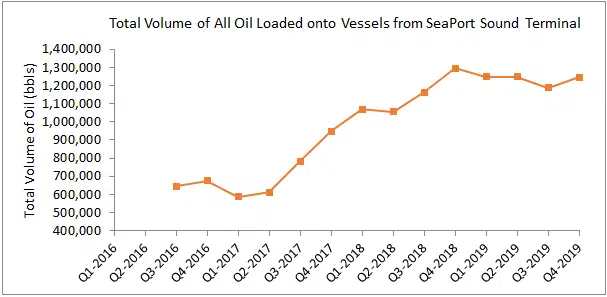
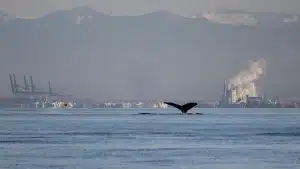
It is common knowledge that our reliance on- and use of- fossil fuels are not only contributing to the global climate crisis, but also worsening public health locally. Tacoma’s two biggest fossil fuel facilities – who are exempt from the Tideflats Interim Regulations – are ramping up how much oil they are transporting through our town and through our waters, with little government oversight. Because our regulations on these companies are so broadly permissive, we have no real idea of the magnitude of the environmental or public health impacts from transporting these staggering volumes of fossil fuels. We don’t yet fully understand the economic consequences of a catastrophic spill or train derailment, but are fully aware of the high cost Washington will face to adapt to rising sea levels and the risks imposed by oil tankers on our clean waters and iconic orca and salmon species.
Tacoma, the City of Destiny, needs to take control of our collective future by strengthening the Tideflats Interim Regulations to include pausing the growth of existing hazardous fossil fuel facilities.
Thank you Eric de Place (Sightline Institute) and Lovel Pratt (Friends of the San Juans) for your guidance on data analysis and interpretation.
Footnotes
†The data used in this analysis was retrieved from Ecology’s Crude Oil Movement Quarterly Reports and through a public records request of Ecology’s Advanced Notice of Transfer data (check out the raw data here). Assumed any deliveries of crude traveling on the combinations of route segments 1, 2, and 3 only are destined for Tacoma.
*Retrieved from April 2019 public testimonial at 2:06:05 and Manufacturing Industrial Council tip sheet
**Calculations based on analysis done for SeaPort Sound’s (then Targa’s) 2013 Shoreline Substantial Development Permit # SHR2013-40000203722.
References
1. City of Tacoma Ordinance No. 28470. (2017).
2. Puget Sound Clean Air Agency. (2018). Notice of Construction Approval No. 11547.
3. Puget Sound Clean Air Agency. (2016). Notice of Construction Approval No. 11069.
4. Friends of the San Juans. (2020). Washington Department of Ecology Public Records Request P000287-031820